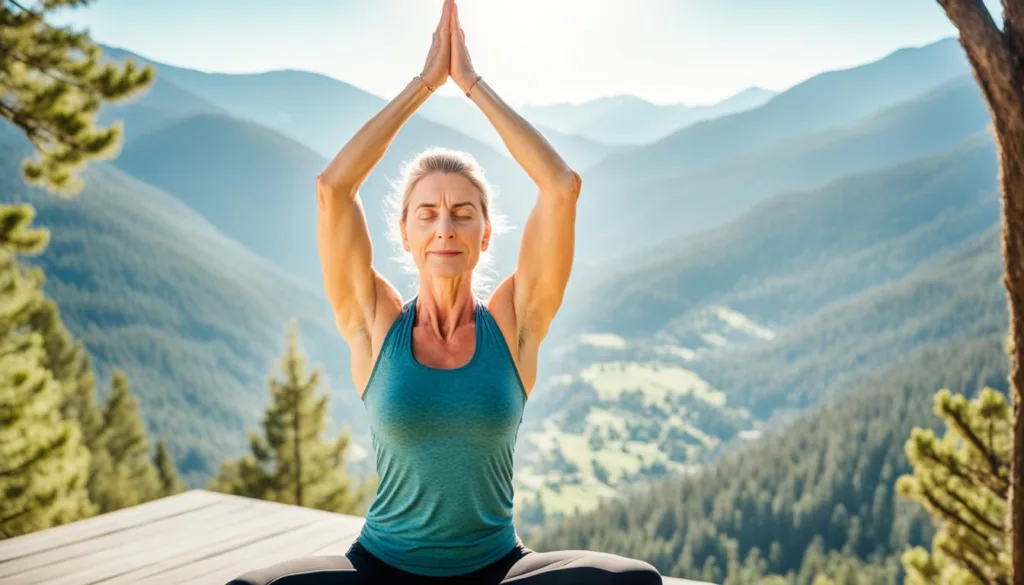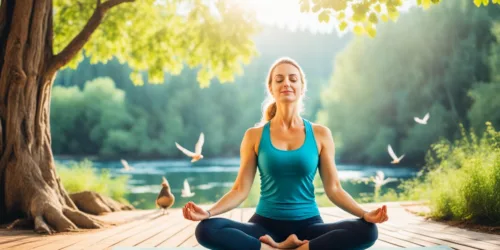Explore Parigha Yoga: Your Path to Flexibility & Balance
Did you know that 85% of individuals practicing yoga report a marked improvement in their overall physical well-being, with a substantial emphasis on enhanced flexibility and balance? This surprising statistic underscores the impactful role yoga plays in health and fitness regimes worldwide, and parigha yoga is at the forefront, guiding numerous beginners and seasoned practitioners alike towards achieving their wellness goals.
Named after the Sanskrit term for “gate,” parigha yoga is your hidden key to unlocking a stronger, more supple body coupled with a resilient mind. Its carefully curated sequences meld dynamic and static movements to sculpt your flexibility while instilling a deep sense of mental focus. Whether you’re dipping your toes into a parigha yoga practice as a beginner or seeking new challenges to heighten your expertise, this transformative style offers a tailored experience that adapts to your skills and ambitions.
Embrace the gate to a more balanced life where physical prowess meets mental acuity. Your journey through parigha yoga beckons, promising to be as enlightening as it is invigorating.
Key Takeaways
- Parigha yoga significantly improves flexibility and balance in practitioners of all levels.
- This practice provides modifications suitable for beginners and challenging asanas for advanced yogis.
- Engaging in parigha yoga for beginners aids in opening up the body’s side channels for better circulation.
- It is a holistic exercise that targets not only the body’s strength but also enhances mental focus and clarity.
- A transformative element of parigha yoga is its ability to lead to greater mental and physical harmonization.
Understanding the Foundations of Parigha Yoga
Delving into the world of Parigha Yoga opens up a path to enhanced well-being through the exploration of distinctive yoga poses for Parigha Yoga and seamless sequences. The practice is more than just a physical regimen; it’s a holistic journey focused on creating symmetry and harmony within your body and life.
What Is Parigha Yoga?
Parigha Yoga is a holistic form of yoga that emphasizes side-body stretching and encourages dynamic movements. These techniques work collectively to foster an openness that both the body and mind can revel in. By adopting Parigha Yoga techniques, you’re embarking on a journey that not only enhances your physical flexibility but also serves as a preparatory ground for deeper meditation practices.
The Philosophy Behind Parigha Yoga
At its core, the philosophy of Parigha Yoga is deeply interwoven with the concept of balance. By achieving equilibrium in our physical bodies, we parallelly cultivate a balanced approach to our lives. This philosophy transcends the mat, enlightening practitioners on the interconnectivity between physical postures, mental resilience, and daily life harmony.
Core Principles of Parigha Yoga Practice
The practice of Parigha Yoga is built upon core principles that promote a profound and enriching experience. Mindfulness is at the forefront, guiding you to stay present in each moment and movement. You are encouraged to move with fluidity, allowing your body to flow naturally from one Parigha Yoga sequence to the next. Alignment is another key principle, ensuring that as you transition through various yoga poses for Parigha Yoga, you maintain a form that prevents injury and maximizes benefits. The culmination of these principles is the synchronization of breath with motion – a dance that orchestrates the rhythm of your practice and breathes life into your Parigha Yoga techniques.
Unveiling the Benefits of Parigha Yoga
Embarking on the journey of Parigha yoga isn’t just about improving your physical form; it’s an all-encompassing experience that nurtures mind, body, and spirit. Let’s delve into the distinct advantages that Parigha yoga offers, revealing why it’s much more than a traditional workout.
Physical Health: Flexibility and Strength
When you embrace the benefits of Parigha yoga, you’ll notice a significant increase in your flexibility and strength. This is particularly evident in key areas of the body like the hips, hamstrings, and shoulders, which are often targeted during practice. The physical benefits extend to enhanced muscle tone, better posture, and a boosted metabolism, making it an ideal practice for those seeking a comprehensive approach to fitness.

Mental Clarity: Reducing Stress and Anxiety
One of the most acclaimed Parigha yoga benefits for mental health is its ability to help reduce stress and anxiety. The combination of meditative practices and focused breathwork allows you to enter a state of deep relaxation, clearing the mind and diminishing the weight of daily pressures. As a result, practitioners often enjoy improved concentration, a more restful sleep pattern, and an overall sense of tranquility that pervades through life’s challenges.
Emotional Well-being: Balance and Inner Peace
As you continue your Parigha yoga practice, you’ll find that it’s not just your body that’s becoming more flexible, but also your emotional responses to the world around you. The practice instills a deep sense of balance and equanimity, teaching you to encounter life’s fluctuations with grace and poise. This inner peace is a cornerstone of emotional well-being and can lead to a happier, more fulfilled life.
Whether you are a novice or a seasoned yogi, the transformative effects of Parigha yoga on your physical health, mental clarity, and emotional well-being are profound and lasting. It’s a discipline that doesn’t just change the way you move, but also the way you think and feel.
Essential Parigha Yoga Poses for Flexibility
If you’re looking to enhance your flexibility through parigha yoga exercises, there are a few yoga poses for parigha yoga that are particularly beneficial. These specific asanas are designed to target the muscles and joints, helping you attain a wider range of motion and a deeper sense of stretch. Let’s look at some of the foundational poses that will serve as pillars in your flexibility journey.

Gate Pose (Parighasana) is a quintessential stretch in the parigha yoga practice. To perform this asana:
- Kneel on the floor with your spine straight and your shoulders aligned with your hips.
- Extend your right leg out to the side, keeping your foot flat on the ground and your toes facing forward.
- Inhale deeply, and as you exhale, slide your right hand down your extended leg.
- Sweep your left arm over your head, creating a continuous line of energy from your left knee to your fingertips.
- Hold the pose for a few breaths, feeling the stretch along your left side body, then switch sides.
The Extended Triangle Pose (Utthita Trikonasana) is another pivotal asana in parigha yoga that focuses on flexing the hips and elongating the hamstrings. Here’s how to embrace the triangle:
- Stand with your feet wide apart, turning your right foot out by 90 degrees and your left foot in slightly.
- Extend your arms to the sides at shoulder height, parallel to the floor.
- As you exhale, bend from the hip joint to bring your right hand down towards your ankle, shin, or the floor.
- Stretch your left arm toward the ceiling, creating a straight line with your arms. Keep your gaze towards your left hand.
- Remain in this pose for a few breaths before you release and move to the opposite side.
Lastly, the Revolved Head-to-Knee Pose (Parivrtta Janu Sirsasana) not only deepens the side body stretch but also encourages spinal flexibility. Execute this twist by following these steps:
- Sit on the floor with your legs extended forward. Bend your right knee outward to a 90-degree angle, resting your right foot against your inner left thigh.
- Reach your right hand to the outside of your left foot as you elongate your left arm over your head, aiming for a hold of the left foot.
- Turn your abdomen and chest skyward, opening your shoulders and maintaining a steady breath.
- Keep the pose for several breaths, then release gently and repeat on the opposite side.
Integrating these parigha yoga exercises into your routine can significantly improve your flexibility and overall well-being. Remember, consistency is key, and with time, you’ll likely notice a profound positive shift in your parigha yoga practice.
Designing Your Personal Parigha Yoga Sequence
Embarking on the path of parigha yoga practice is an invigorating experience that promises substantial growth in both your physical and mental wellness. To harness the full potential of this practice, it’s essential to tailor a parigha yoga sequence that resonates with your unique needs and aspirations. Whether you’re a novice or a seasoned yogi, your journey towards a more flexible and balanced self begins with custom-crafted asanas (poses). Let’s delve into the guidelines that will aid in aligning your routine with your personal objectives and proficiency.
Guidelines for Creating an Effective Routine
Constructing an effective parigha yoga routine requires an understanding of progression in postures—from gentle warm-ups to more intense stretches. Start with grounding poses to stabilize your base and establish steady breathing. Progression entails moving through a curated parigha yoga sequence that encompasses a blend of dynamic stretches and strengthening postures, designed not only to enhance flexibility but also to bolster the stability of the mind and body. Mindfulness should be the undercurrent of your practice, allowing you to deeply connect with each movement and breath.
Incorporating Breathwork and Meditation
Integrating parigha yoga techniques of pranayama and meditation will elevate your practice, forging a profound mind-body synergy. Ujjayi breath calms the mind and heats the body, ideal for starting or concluding your routine. Incorporate alternate nostril breathing (Nadi Shodhana) to harmonize the hemispheres of your brain and settle your nervous system. Concluding with a guided meditation or a period of silent reflection can consolidate the benefits of your asanas, instilling a sense of peace and fulfillment post-practice. In all, your personalized parigha yoga sequence is not just a workout regime—it’s a holistic ritual that nurtures your entire being.
FAQ
What Is Parigha Yoga?
Parigha yoga, named for the Sanskrit word for “gate,” is a yoga practice that targets physical flexibility, strength, and mental balance. This style includes a mix of dynamic and static poses designed to open the body’s side channels, thus enhancing circulation and lung function, among other benefits. It is suitable for all levels, offering modifications and challenges to suit each individual’s practice.
What are the core principles of Parigha Yoga practice?
The core principles of parigha yoga include mindfulness, fluidity in movement, and careful alignment of the body, all while synchronizing breath with motion. These foundational elements help to stretch and strengthen the body comprehensively and create harmony between the physical and mental aspects of one’s self.
How can Parigha Yoga improve my flexibility and balance?
Through its focus on side body stretching and dynamic movements, parigha yoga helps improve flexibility, especially in the hips, hamstrings, and shoulders. Balance is enhanced as the sequences encourage stability and core engagement, both physically in poses and mentally through concentration and focus.
What benefits can Parigha Yoga have on my mental health?
Parigha yoga can significantly benefit mental health by reducing stress and anxiety levels through mindful movement, meditation, and focused breathwork. This reduction in tension can create better sleep patterns, heightened energy levels, and a greater sense of emotional stability and inner peace. It encourages present-moment awareness and equanimity amidst life’s challenges.
Can beginners practice Parigha Yoga?
Absolutely! Parigha yoga is beginner-friendly, and poses can be modified to suit different levels of fitness and flexibility. Starting with the basics allows beginners to build confidence, strength, and flexibility before progressing to more advanced techniques.
What are some essential Parigha Yoga poses for improving flexibility?
Key poses in parigha yoga for enhancing flexibility include the Gate Pose (Parighasana), Extended Triangle Pose (Utthita Trikonasana), and the Revolved Head-to-Knee Pose (Parivrtta Janu Sirsasana). These poses target the side body and help in increasing the range of motion and flexibility.
How do I create an effective Parigha Yoga sequence for myself?
To create an effective parigha yoga sequence, start with grounding poses that focus on breath and gentle movement. Gradually progress to dynamic stretches and conclude with deeper, static holds. It’s important to listen to your body and include modifications or advancements to match your comfort and skill level.
How can I incorporate breathwork and meditation into my Parigha Yoga practice?
Breathwork (pranayama) and meditation are integral parts of parigha yoga and can be woven into practice either at the beginning for centering and calming the mind or at the end for relaxation. Techniques such as Ujjayi breath, alternate nostril breathing (Nadi Shodhana), and guided meditations can help to deepen the mind-body connection and enhance the benefits of the physical poses.






